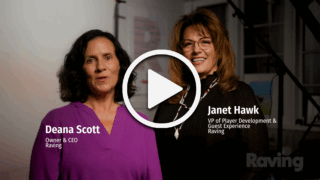
Using social media data to learn about your players
I have a good friend who spends a lot of time on Facebook. She posts interesting anecdotes about her daughter’s school activities, hilarious family vacation stories, and lots of pre-meal pictures of food. Most of my friends know that I spend very little time on social networking sites. But when I do have some time to indulge in online social voyeurism, I actively seek out her posts because of the hilarity and wittiness of her writing.
I asked her one day about where she finds the time to post as often as she does. She explained that she usually posts on the go from her phone, because she wants her friends to feel like they are active participants in her life. She reasoned that her online social presence was a logical extension of her physical presence. When she posts something new, she immediately gets feedback from her friends through likes and comments that amplify and validate her social presence, which is similar to if she were actually in the presence of her friends.
This feedback loop allows her to judge the effectiveness of her online message. If she tells a funny story, she expects and receives a high number of comments and likes. But if the story falls flat, she won’t see the “love.” And she needs this feedback to create better posts.
Data analytics in disguise
As I listened intently to my friend’s explanation of her online behavior, I suddenly had an epiphany – my friend was using these signals of data to evaluate how effectively her message was resonating with her audience. Moreover, she uses this insight to better create new messages that allow for deeper engagement. I was stunned. She is a data analyst in disguise!
Your casino’s online social presence is a logical extension of the on-property casino experience. What you say and how you interact has implications for player engagement. But to understand that engagement and to influence behavior requires that data be harnessed in a way that creates insight.
Data analysts use various techniques to understand the effectiveness of messages shared through social channels. The data captured is used to find ways to better engage with audiences. Social analytics allow for the collection and aggregation of social media data in order to discover meaningful patterns that may lead to actionable insight.
Data to insight: Using social analytics to evaluate progress of investments
When you execute a marketing program, you will often run a social campaign in parallel. Many times this is done to spread the message to a wide audience within social channels. However, in addition to a “louder mouthpiece,” social campaigns return data signals that can be mined, allowing you to better understand the impact of your investment. Likes, shares, retweets, views, responses, etc., can help you craft a story that explains how the investment is playing out over time. And to truly assess impact, this data may be tied back to on-property engagement in order to evaluate current or future game play.
You can also see a historic view of social media followers you have gained each day and compare that to the followers of your competitors. This type of comparative analysis, which is especially helpful in hyper-competitive markets, can arm your marketing team with key indicators that showcase relative performance. You can also gauge the impact of your followers by assessing their social influence. If your follower base is high and they mention your property, the social impact of the message can be more broad-based.
Although these techniques are not a complete assessment of the true reach of all your property’s messages, they can serve as a useful proxy to help guide the impact of investment decisions.
Insight to action – Social analytics help you better allocate resources
The ultimate panacea for a marketer is to apply action from learned insight that saves money, and increases revenue. For example, upcoming entertainment and gaming promotions usually have some correlated social response. Marketers can create targeted offers to social media influencers who could further amplify your message to their large networks of followers. Additionally, Facebook and Twitter data can return who your followers are. And in some cases, the tweets can be geocoded to show where users are physically located. This may help you create geo-targeted messages for your audience.
There are also advanced ways to evaluate the sentiment of social posts over populations of users. Your patrons are telling you something: “Your free play promo is awesome!” or “I hate your chicken wings” or “Your hotel bathrooms need more soap.” Whatever the message, your patrons may be using social networking methods to communicate with you. Sentiment analysis is a type of data automation that simplifies the process of evaluating the tone in Twitter or Facebook messages. For example, if patrons complained about the food in the casino bar and consistently talked about it on social media, you can use that data to identify where the negative sentiment is coming from, address the problem internally, and follow up with directed messages to the complaining patrons.
Where to start
Use free tools – Start by using the analytics tools within the social media networks themselves. Twitter Analytics, for example, tells you at a glance your number of tweets, tweet impressions, profile visits, mentions and followers. Facebook Insights gives you page post metrics, such as the number of people that posts have reached, clicks and reactions. And all of this can be exported to Excel.
Analyze your followers – Many of your social users are players who will spend money with you. Take the time to get to know who they are and how they respond in social interactions as a population.
Analyze reach – Evaluate how your posts are performing. Shares, likes/favorites, retweets, views, etc. It is best to evaluate this performance over time.
Identify influencers – Influencers don’t necessarily have to be famous or spend money with you. They can be people hidden in your list of contacts who create a disproportionate amount of activity. Use your social data to identify these people in order to amplify your messages.
As for my Facebook friend, I can’t stop reading her posts. I just finished watching a video that she posted of a leopard caring for a baby baboon. Well … I suppose not all of her posts are witty. But I sure do come back for more every time.







